- Home
- Lynne Olson
Madame Fourcade's Secret War Page 2
Madame Fourcade's Secret War Read online
Page 2
But she knew that the end of her life would likely mean the end of Alliance as well. After all the contributions her network had made to the Allied war effort, including to the success of the D-Day landings just a month before, Fourcade couldn’t abide the idea of its destruction. She had to find a way to escape.
* * *
—
THROUGHOUT MY WRITING CAREER, I have specialized in works of history that tell sweeping, panoramic stories, chiefly set during World War II and featuring a multitude of characters. As much as I’ve enjoyed writing these books, I’ve often felt a sense of frustration at having to dismiss in a few sentences or paragraphs individuals who, in my opinion, deserved far more attention than I was able to give them.
That was especially true of my last book, Last Hope Island: Britain, Occupied Europe, and the Brotherhood That Helped Turn the Tide of War. I was drawn to a number of compelling figures in it, but none more than Marie-Madeleine Fourcade. How could one not be fascinated by the story of this cultured young woman from a well-connected family who had dreams of becoming a concert pianist but ended up as arguably the greatest wartime spymaster in Europe?
M.R.D. Foot, the British historian widely considered the leading authority on European resistance movements in World War II, has observed that “resisters shared one characteristic besides bravery: contrariness. They were disputatious, argumentative, non-conformist, did not enjoy being ordered about.” Fourcade is the embodiment of that observation.
All her life, she rebelled against the norms of France’s deeply conservative, patriarchal society, in which women were largely confined to their domestic duties as wives and mothers and still did not have the right to vote. “She was very independent,” noted her younger daughter, Pénélope Fourcade-Fraissinet. “She had a mind of her own from the beginning.”
When the war broke out, Fourcade had long been estranged from her husband, a French army officer serving in North Africa. She had two young children whom she dearly loved but did not see for months, even years, during the conflict.
When she took over as a chef de résistance, she initially had doubts about whether male resistance members would accept her leadership. Although some were hesitant at first, most were won over by her courage, resilience, formidable organizational skills, and determination to stay in the field with her agents. The converts included a bevy of traditionalist former military officers who, as one observer later wrote, were “not inclined to feminism.” “She had enormous charisma,” recalled Charles-Helen des Isnards, whose father had been one of Fourcade’s top lieutenants. “She was one of those people who dominate a room just by being in it.”
In the years immediately following the war, Fourcade was showered with tributes for her remarkable wartime achievements, but today she and Alliance are relatively unknown outside of France. Although there have been floods of books and films about the French resistance, little has appeared about her and her network—or, for that matter, about any other intelligence organization. The lion’s share of attention has gone to groups and individuals specializing in sabotage and other forms of open rebellion against the Nazis. A second strand of resistance activity—escape lines—has also received considerable notice. Yet as exciting and dramatic as their stories were, neither played a crucial role in winning the war. Saboteurs and other resistance fighters in France were certainly important after D-Day, but they did little to obstruct the Germans before then. Escape networks did heroic work in smuggling shot-down Allied airmen and others out of occupied Europe and back to freedom, but their actual contribution to victory was small.
By contrast, the third strand of activity—espionage—was vitally important to the Allied cause from the first day of the war to the last. In order to plan both defensive and offensive operations against the Germans, Allied military commanders were dependent on spies in France and the rest of occupied Europe to inform them where the enemy was and what he was doing. In France, dozens of intelligence networks sprang up to meet that need. Some, like Alliance, worked closely with MI6, Britain’s chief foreign intelligence agency. Others were associated with Charles de Gaulle and his Free French movement in London. Yet despite their oversized impact on the war’s outcome, intelligence networks have gotten short shrift from historians, novelists, and filmmakers, largely because of the secrecy of their operations.
In the late 1960s, Marie-Madeleine Fourcade pulled back the veil cloaking her wartime activities in her gripping memoir, Noah’s Ark, which was rightly described by MI6’s Kenneth Cohen as “a Homeric saga” of her and Alliance’s daily life under German occupation. But like Fourcade herself, the memoir is little known today.
Another explanation for Fourcade’s relative obscurity is her gender: As a female chef, she does not fit into the traditional historical narrative of the French resistance—namely, that its leaders were men. “To this day historians of the Resistance persist in the belief that no women led Resistance networks, blatantly ignoring the work of Marie-Madeleine Fourcade,” the British historian J. E. Smyth noted in 2014.
One of the reasons for this book, then, is to tell her story and give her the credit she is due. But I also wrote it to shine a spotlight on the thousands of agents she led—ordinary men and women who refused to accept the destruction of human values and the dishonor and degradation of their country.
Many years after the war, an American journalist asked Jeannie Rousseau, one of Marie-Madeleine’s operatives, why she had risked her life to join Alliance. “I don’t understand the question,” replied Rousseau, who was responsible for one of the greatest Allied intelligence coups of the war. “It was a moral obligation to do what you are capable of doing. It was a must. How could you not do it?”
FOUNDED IN VICHY IN SEPTEMBER 1940 BY GEORGES LOUSTAUNAU-LACAU AND MARIE-MADELEINE FOURCADE, THE CRUSADE INTELLIGENCE NETWORK (LATER CALLED ALLIANCE) MOVES ITS HEADQUARTERS FROM VICHY TO PAU IN EARLY 1941 AND TO MARSEILLE LATER THAT YEAR.
Her sister’s drawing room was already crowded when Marie-Madeleine Fourcade arrived. In one corner, Georges, her brother-in-law, was deep in discussion with a cluster of male guests. Spotting her sister in another corner, Marie-Madeleine crossed the room to join her.
Yvonne introduced her to several women, who, after acknowledging the newcomer, returned to their conversation about children, their latest travels, and their incessant problems with servants. At one point, between sips of tea, a small, birdlike woman named Yvonne de Gaulle held forth on the soothing virtues of the countryside and how important it was to have a house in the country where a busy man like her husband could find a quiet refuge.
Her attention wandering, Marie-Madeleine glanced around the room. She recognized several of the men—a number of them military officers like Georges, along with a scattering of diplomats, journalists, and business leaders. Ever since she’d returned to Paris, her sister and brother-in-law had included her in their circle of influential friends, many of whom frequented the lively late-afternoon salon that the couple had established at their apartment on rue Vaneau, not far from the French capital’s government ministries and embassies.
She caught the eye of Georges, who beckoned to her. As she joined the group around him, she was aware of the appreciative glances directed her way. Cool and elegant, with porcelain skin and high cheekbones, the twenty-six-year-old blonde was used to being the object of male scrutiny.
After introducing her to a couple of guests she had not yet met, Georges mentioned her passion for cars and fast driving and boasted about her success in a recent long-distance car rally. For a minute or two, she and the others debated the merits of various cars, including the speedy model she owned—a Citroën Traction Avant. But the conversation soon returned to the subject that had preoccupied the men from the moment they had arrived that afternoon: Nazi Germany’s shocking occupation of the demilitarized Rhineland just a few weeks before.
On March 7, 1936, Ger
man troops had marched into the Rhineland, a strip of western Germany straddling the Rhine River and bordering France, Luxembourg, Belgium, and the Netherlands. After Germany’s defeat in World War I, the area had been declared a buffer zone, and a ban had been imposed on any installation there of German forces or fortifications. Adolf Hitler’s defiance of the ban was his most flagrant violation to date of the 1919 Versailles Treaty and his most dramatic challenge thus far to the Western allies Britain and France.
If either country had responded with force, Hitler’s troops, as he later acknowledged, would have retreated immediately. But neither the British nor French lifted a finger to stop the incursion—a failure that appalled those at Georges and Yvonne’s salon on that lovely April afternoon.
Several of the guests were army intelligence officers, who, for the last three years, had been providing information to the French government detailing Hitler’s mounting preparations for war. Indeed, in the past few months they had passed on advance intelligence of the Rhineland incursion itself. To all these warnings, government officials and the top military command had paid little heed.
The top brass were equally indifferent to increasingly urgent calls by some of their underlings for the modernization and reform of the French military. As one observer later put it, “The minds of the French generals had ground to a halt and were already thickly coated with rust.” In their preparations for a future war, members of the high command remained committed to the kind of defensive warfare that had eventually brought the Allies, at an extremely high cost, a victory in World War I. They paid little or no attention to the swift technological advances in the development of such offensive weapons as planes and tanks. They also went out of their way to block the advancement of younger, more vigorous officers who preached the need for a revolution in military tactics and strategy.
Two of the most prominent members of that younger group—Lieutenant Colonel Charles de Gaulle and Major Georges Loustaunau-Lacau—took center stage in the discussion on rue Vaneau, engaging in a debate that quickly escalated into a full-blown argument. It soon became obvious to Marie-Madeleine that the two officers viewed each other as rivals, which, considering how much they had in common, was perhaps not surprising.
They both were products of Saint-Cyr, France’s foremost military academy, and the elite École Supérieure de Guerre, the country’s graduate war college. Both had fought in World War I, been wounded, and received multiple citations for bravery. After the war, they had served at different times on the staff of Marshal Philippe Pétain, the hero of the Battle of Verdun, who had held several key postwar posts—commander in chief of the army, inspector general, and minister of war. The forty-five-year-old de Gaulle and the forty-two-year-old Loustaunau-Lacau were brilliant, ambitious, and egocentric, with a rebellious streak that had gotten them in considerable trouble at various times with Pétain and other military superiors. Each loved the spotlight, and neither wanted to share it with the other.
After Germany occupied the Rhineland, de Gaulle had submitted an article predicting its disastrous consequences to the influential journal Défense Nationale, which refused to publish it. Now, leaning against the apartment’s fireplace mantel, he criticized the high command’s tactical and strategic ineptness, blasting its reliance on prepared fortifications like the Maginot Line and arguing for the creation of a fast-moving mechanized army working closely with and supported by aircraft. Loustaunau-Lacau interrupted, dismissing de Gaulle’s idea of a strike force as unworkable. As they argued, they seemed to agree on only one point: If the French military were not immediately reshaped, the army would collapse, and the country would be crushed by Germany in a war that was drawing ever closer.
Fascinated by the verbal fireworks between them, Fourcade had no idea of the profound impact that both men would soon have on her life.
* * *
—
AS IT HAPPENED, FOURCADE had much in common with these two iconoclastic officers, including a strong will and a taste for risk and rebellion—traits not often seen in young Frenchwomen from well-to-do families like hers. But then again, few genteel Frenchwomen had the kind of unconventional pedigree and upbringing that she did.
Boldness and daring seemed to run in Marie-Madeleine’s family, with one of her distant ancestors, the Marquis de Bacqueville, topping the list of risk takers. Like many Frenchmen in the eighteenth century, the marquis had been fascinated by the idea of flying. Unlike his compatriots, he decided to test the possibility himself. On March 19, 1742, he appeared, with large white wings attached to his arms and legs, on the roof of his house in Paris, overlooking the Seine. The fifty-four-year-old nobleman had told friends and acquaintances of his planned experiment, and a large crowd, including the writer Jean-Jacques Rousseau, had gathered in the streets below.
Wings outstretched, the marquis hurled himself off the roof—and promptly plunged several feet. But then a light wind came up, keeping him aloft and pushing him slowly across the river, to the gasps and cheers of the spectators. It appeared that he might actually make it to the opposite shore when the wind died as abruptly as it had risen, and he fell on top of a houseboat in the Seine, breaking his leg. For months, the marquis was the butt of jokes among le tout Paris. And yet, as his descendants were quick to point out, he actually did fly, if only for a few moments.
In her own way, Marie-Madeleine’s free-spirited mother, Mathilde Bridou, displayed a similar zest for leaping into the unknown. Soon after she married Lucien Bridou in the early 1900s, he was assigned to Shanghai as an executive for Messageries Maritimes, a French shipping line responsible for most of the passenger and trade traffic to and from France and its large colonial empire.
When Mathilde made it clear she planned to accompany Lucien to Shanghai, her family was aghast. How could she expose herself, not to mention any children she and Lucien might have, to the dangers of living in China—the appalling climate, the myriad diseases, the earthquakes, the constant danger of riots and revolution? Mathilde brushed off all such warnings, although when her second daughter, Marie-Madeleine, was born in 1909, she had agreed to return home to Marseille for the birth.
Like their parents, Marie-Madeleine and her siblings, Yvonne and Jacques, were captivated by the teeming city in which they grew up. Known as the Paris of the Orient, Shanghai was one of the world’s leading seaports, as well as the largest, richest, and most modern metropolis in Asia. It was by far the most prominent of China’s five so-called treaty ports, which the Chinese, under duress from Britain, France, and other Western countries, had opened to foreign trade in the nineteenth century.
In the first three decades of the twentieth century, Shanghai was considered the essence of exoticism, mystery, and excitement. As an open city, it required neither a visa nor passport to enter, providing a haven for an extraordinarily eclectic array of immigrants, among them White Russians fleeing from the Bolsheviks; Chinese warlords and revolutionaries; American and European gangsters and spies; drug smugglers; and international arms dealers.
To many, Shanghai epitomized “the stylish, the new, the audacious in everything from dress to politics.” As one observer put it, “You could be a cosmopolitan Parisian or Londoner, but you simply were not chic enough unless you had been to Shanghai.”
Much of Shanghai’s foreign population, including Marie-Madeleine’s family, lived in spacious, airy, European-style houses on tree-lined avenues in the city’s French quarter. But it was Shanghai’s vibrant waterfront and its bustling downtown streets that most attracted the young Marie-Madeleine, who, with her sister and brother, were given free rein by their equally adventurous parents to explore the city. She had a slight limp—the result of a congenital hip displacement that she had inherited from her mother—but it never seemed to slow her down.
On the Bund, Shanghai’s major avenue, cars and trams shouldered their way through throngs of bicyclists, rickshaw coolies, and peasants carryin
g ducks and other foodstuffs on bamboo poles, everyone seemingly indifferent to the blare of car horns and the whistle blowing and shouted commands of Shanghai’s policemen, most of them turbaned Sikhs from the raj. The noise was cacophonous, with at least a dozen different languages assaulting one’s ear.
On the Whangpoo River, the boom of ships’ horns added to the din. As crowded as the Bund, the river was alive with wooden sampans, barges, and junks, their sails spread wide, dodging between the moorings of passenger ships and freighters from all over the world, as well as British and French warships, their decks bristling with guns.
“My mother loved the scenery of China and was always drawing our attention to everything around us,” Fourcade recalled. “She would take us all out, including my father, on the Chinese canals, on a houseboat that was provided to our family. We’d float under the marvelous bridges and look at the villages and countryside.”
On occasion, the Bridou children, accompanied by their Chinese amah, ventured beyond downtown Shanghai into the old Chinese city, its dark, narrow, cobblestone streets packed with beggars, fortune-tellers, letter writers, and street vendors, from whom they would buy sweets—one of Marie-Madeleine’s favorite childhood memories.
As cosmopolitan as Shanghai was, the British dominated the city economically and politically and set the tone for the foreign community. At the French lycée she attended, Marie-Madeleine became friends with several British girls. “They wanted to speak French, and I wanted to speak English, and we all ended up bilingual,” she later remarked. During those years, she fell in love with all things British, including afternoon tea.
* * *
—
IN 1917, MARIE-MADELEINE’S IDYLLIC life in Shanghai abruptly ended when her father contracted a tropical disease and died soon afterward. Mathilde Bridou moved the family to Paris, where Marie-Madeleine was enrolled in a convent school catering to the daughters of aristocratic and otherwise well-connected families. She then studied at a leading Paris conservatory, with the hope of becoming a concert pianist.

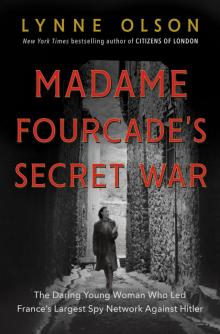 Madame Fourcade's Secret War
Madame Fourcade's Secret War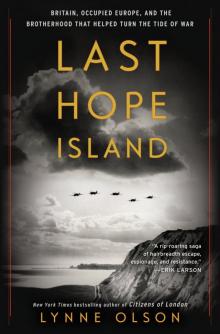 Last Hope Island
Last Hope Island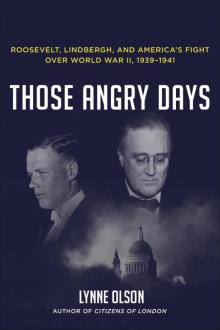 Those Angry Days
Those Angry Days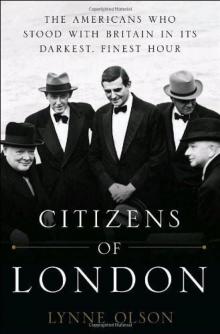 Citizens of London
Citizens of London Citizens of London: The Americans Who Stood With Britain in Its Darkest, Finest Hour
Citizens of London: The Americans Who Stood With Britain in Its Darkest, Finest Hour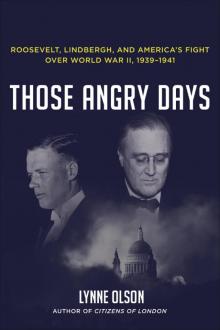 Those Angry Days: Roosevelt, Lindbergh, and America's Fight Over World War II, 1939-1941
Those Angry Days: Roosevelt, Lindbergh, and America's Fight Over World War II, 1939-1941